HUD's FY99 Budget
Congressional Justifications
Office of Housing
General and Special Risk Insurance Account
GENERAL AND SPECIAL RISK INSURANCE ACCOUNT
PROGRAM HIGHLIGHTS
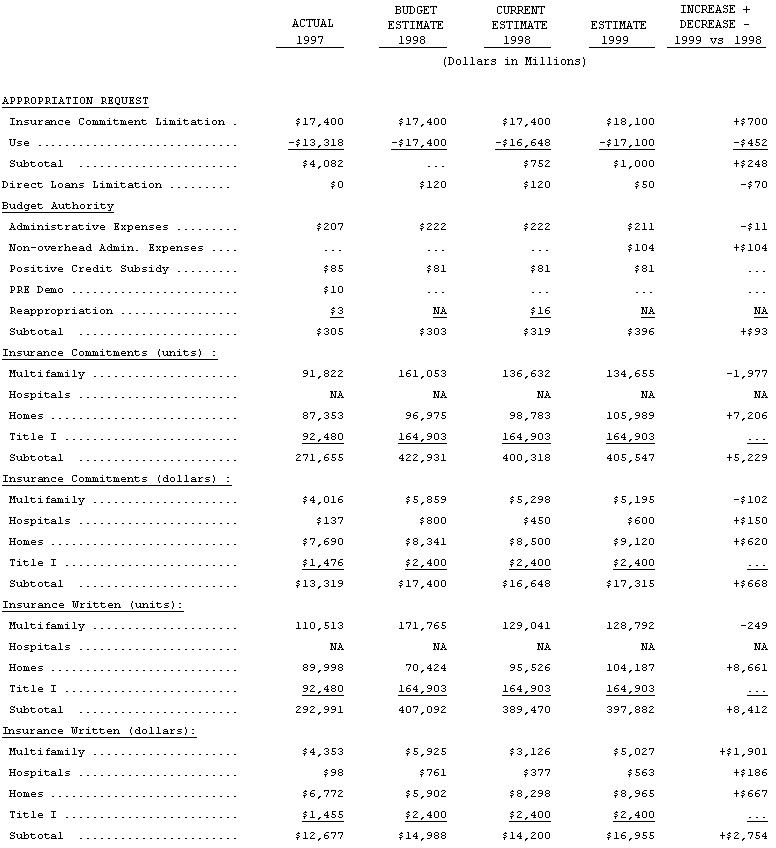
NA = Not Applicable
SUMMARY OF BUDGET REQUESTS
A. Credit Limitation. A limitation on new insurance commitments for fiscal year 1999 of $18.1 billion is requested. It is estimated that insurance will be written for 397,882 housing units in fiscal year 1999.
A direct loan limitation of $50 million is requested. Of this amount, $30 million is intended for bridge loan financing to facilitate the sale of multifamily projects, and $20 million is for 5-year purchase money mortgages for non-profit and governmental agencies to make HUD-acquired single family properties available for resale to purchasers at or below 115 percent of area median incomes.
B. Appropriations. The 1999 request includes $81 million in new appropriations and assumes the availability of $49 million out of the total unreserved carryover of $314 million primarily from note sales proceeds from previous years. Total credit subsidy of $130 million would be available for reservations related to various multifamily and hospital loan programs in the GI/SRI program account. It is estimated that permanent budget authority of $66 million will be needed for the GI/SRI liquidating account to pay for claims with debentures. Appropriations are also requested in the amount of $193 million for administrative expenses for transfer to the Departmental Salaries and Expense Account and $18 million for the Office of Inspector General. The Department is requesting an appropriation of $104 million for FHA contract expenses for payment from the GI/SRI program account. These contract costs were formerly charged as a direct program expense against the Liquidating and Financing Accounts.
The $81 million of credit subsidy together with $49 million of carryover credit subsidy represents the net present value of the expected costs to the Government of insurance commitments of $2.1 billion in 1999 in those multifamily and hospital program categories where costs are projected to exceed fee and premium income over the duration of the loans.
The 1999 request also includes estimated commitments of $15.2 billion in products where the present value of projected revenues from new insurance exceeds the present value of estimated costs, resulting in the generation of negative credit subsidy. Negative credit subsidy of
$143 million from new insurance is the estimate for fiscal year 1999 which will be a discretionary offset against the total appropriation for the Department.
In fiscal year 1998, the credit subsidy request of $152 million consists of $81 million from appropriations and the application of $71 million in carryover from prior years.
PROGRAM DESCRIPTION
A. GI/SRI Insurance Products. The Department will continue to offer a range of alternative products to address specialized mortgage finance needs. These products include insurance for mortgages for rehabilitation, development, and refinancing of apartment buildings; hospitals; assisted living and nursing home facilities and Title I loans. The Department will work to expand the use of new products that were introduced in fiscal year 1997. These new products will enhance the ability of for-profit and nonprofit developers to develop and rehabilitate affordable housing.
The Department is planning to introduce additional multifamily and hospital products. In 1998 the neighborhood improvement loan product would be available to insure loans for the construction or renovation of community facilities in currently insured multifamily projects. The Department is also introducing two new healthcare products to meet the demands of the rapidly evolving healthcare industry. Over the past 50 years FHA has been a leader by setting industry standards and introducing innovative and timely new products that have been mainstreamed by the mortgage industry. The Department's insurance products will continue to provide decent, safe and affordable housing needs for the nation. In addition, its multifamily products are consistent with the President's agenda of moving people from welfare to work and the targeted, community rebuilding efforts.
B. Hospital Products.
Hospital Risk-Sharing Program. The Department expects to introduce a Section 242 Hospital Risk-Sharing program in fiscal year 1998. The program will be an alternate to FHA's Section 242 full insurance program for hospitals. It is the Department's belief that a hospital risk-sharing program will provide additional opportunities for hospitals to acquire lower cost financing through the use of FHA insurance as a credit enhancement vehicle and will reduce risk in the Section 242 program portfolio.
The Section 242 risk-sharing program will allow lenders to share in the insurance premium in return for agreeing to take on a specific percentage of risk should the hospital default. The program also provides for the underwriting analysis, development of covenants, and loan servicing functions to be performed by the Department's risk-sharing partner. However, endorsement authority and approval of covenant requirements would remain vested in HUD. The Department believes that participation by lenders in the Section 242 Hospital Risk-Sharing Program will begin slowly after the product is introduced to the market place. However, anticipating the product�s acceptance by the industry and demand for FHA hospital insurance, it is projected to account for a larger volume of FHA hospital business in the future.
Section 223f Hospital Program. The Department will make the Section 223f Hospital Program available to the marketplace in fiscal year 1999. The purpose of the program is to meet the refinancing needs of the hospital industry by providing a program that is specifically designed for that purpose. Given the current interest rate climate, the Department believes that the Section 223f hospital refinancing program will be received positively by the industry and will elicit a moderate level of participation as soon as it is made available as a financing tool. The Department also believes that the Section 223f hospital program will assist in the geographic diversification of the FHA Hospital portfolio. It is also expected to reduce risk to the insurance fund by attracting more creditworthy borrowers, as seasoned hospitals opt for refinancing through the program.
C. Credit Subsidy Rates. Over the past years, the Department has devoted significant efforts to developing realistic credit subsidy estimates. The multifamily and hospital credit subsidy estimates were developed after extensive consultation with OMB by FHA and its contractor, Price Waterhouse. The Department has focused on the major factors indicating how loans will perform. These "critical" loan performance assumptions are:
1. Historical Performance Experience;
2. Claim Rates and Prepayment Rates;
3. Claim Ratios; and
4. Loss Recovery Rates
The analyses used historical loan data for program assumptions but did not solely rely upon past performance. The analyses incorporated the recovery rate results of the initial mortgage sales program along with the recovery rates from the property disposition program. Where historical data was not available on claims and prepayments, particularly for some of the new products, a conservative approach that resulted in higher credit subsidy estimates was used.
The following table breaks out the estimated level of activity by program that is estimated in fiscal years 1998 and 1999. These estimates are based on the commitment limitation and positive subsidy available.
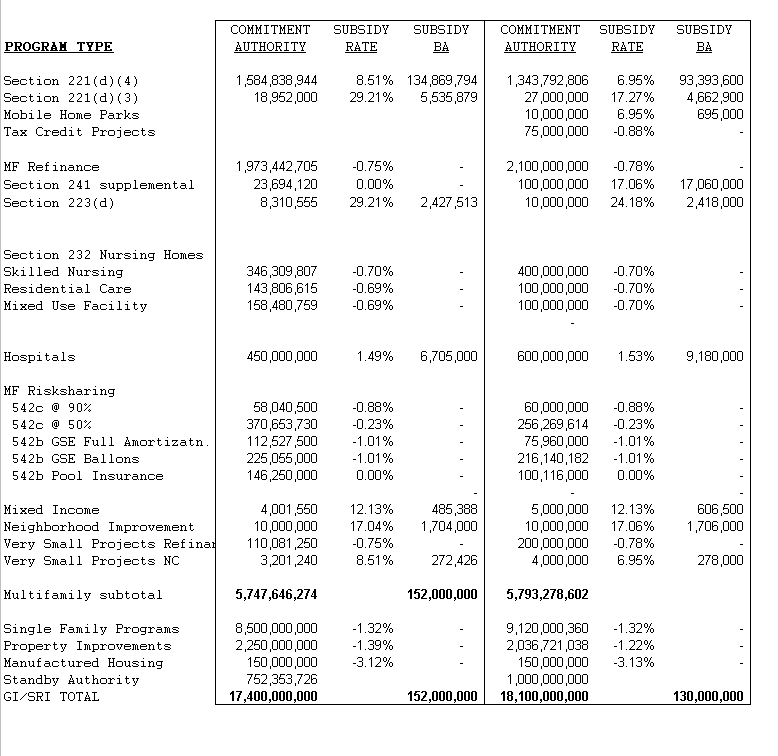
D. FHA Multifamily Portfolio Reengineering. The Multifamily Assisted Housing Reform and Affordability Act of 1997 was enacted in the 1998 Appropriations Act. The permanent program takes effect in fiscal year 1999, with transition provisions for project-based Section 8 contracts expiring during fiscal year 1998. The pending expiration of oversubsidized Section 8 contracts at unsustainable rent levels in many FHA-insured housing projects has been a dominant factor in recent FHA budget projections, and the enactment of this legislation clarifies the outlook for FHA activities and costs.
During fiscal year 1998 owners of multifamily projects with expiring contracts at current rents in excess of 120 pecent of FMRs will have a choice of renewing their Section 8 contracts at 120 percent of FMRs, opting out of the Section 8 program, or of participating in mortgage restructuring intended to make their projects supportable at comparable market rents, and affordable for 20 years. Owners of projects with current rents less than or equal to
120 percent of FMRs may have contracts renewed at the same rent in effect at contract expiration. Beginning in fiscal year 1999, renewal of Section 8 contracts will be at rents that do not exceed comparable market rents, both for projects that are above 120 percent of FMRs, and those that are below 120 percent.
The majority of those FHA-insured projects that currently have above-market rents would not be able to meet their debt service and operating expenses if rents were reduced to comparable market levels. In conjunction with such rent reductions, FHA is faced with the costs associated with restructuring mortgages, or with default claims and foreclosures. Because the scope of the program in 1998 is focused on projects with current rents above 120 percent of FMR, the major impact on FHA costs is estimated to occur between 1999 and 2001, when the mortgage restructuring legislation expires.
Under the 1996 demonstration program, 36 of the 110 proposals submitted were conditionally accepted with modifications, with the remainder rejected or disqualified. Out of these 36 projects, 14 eventually dropped out at the election of the owner. Under the 1997 demonstration, 322 properties with expiring Section 8 contracts in excess of 120 percent of FMRs were eligible for the demonstration. Of these 322 properties, 101 elected renewal at 120 percent of FMRs, 7 opted-out of the Section 8 program, 54 were renewed at current rents temporarily, 32 were determined to be not qualified, and the remaining 128 properties applied for the demonstration program.
The principal tool for restructuring is the availability of a new second mortgage program, under which the proceeds may be used to pay down a first mortgage to the extent necessary so that the remaining mortgage will be sustainable at comparable market rents. Other tools under the permanent legislation that is effective in fiscal year 1999 include partial payments of claim for amounts of existing debt not capable of repayment under the terms of the second mortgage program, refinancing of debt, FHA mortgage insurance, and other credit enhancements. The second mortgage must be sized so that it can be reasonably expected to be repaid. FHA outlay estimates divide the insured multifamily portfolio into 4 classes: (1) projects that can be maintained at market rents without debt restructuring; (2) projects in need of a second mortgage used to pay down a part of the first mortgage; (3) projects supportable at market rents only if the full first mortgage is removed and (4) projects not sustainable at market rents even without any debt service. The fourth category includes projects located in geographic areas with very low market rents, such as some rural areas.
Under the permanent program, the needs of projects for rehabilitation to be restored to a non-luxury standard adequate for their rental markets may be met through debt restructuring, appropriations, the new grant program from the reuse of Section 236 interest reduction payment recaptures, replacement reserves, residual receipts, owner equity, and other project resources. Owners or purchasers of restructured projects must contribute from non-project resources at least 25 percent of the amount of rehabilitation assistance received.
Of the 36 projects conditionally accepted under the 1996 demonstration, 4 had Loan Management Set-Aside (LMSA) Section 8 contracts, and 32 had New Construction Substantial Rehabilitation (NC/SR) contracts. Only a small fraction of the LMSA contracts are above 120 percent of FMR, so despite the fact that, by 1998, 378 thousand of the total 457 thousand units in projects with LMSA are expiring, most of the restructuring activity in 1998 is estimated to occur in connection with NC/SR projects. By 1999, fully 431 thousand units in projects with LMSA will be expiring, and with the restructuring universe expanded to projects below 120 percent of FMR (but greater than market), LMSA restructures will become a more significant part of the total. According to the Ernst and Young study provided to Congress last year, about one-third of LMSA contracts are above market, whereas about 90 percent of the NC/SR contracts on FHA-insured projects are above market. The table below applies these percentages for the entire stock of insured, assisted properties, but from year-to-year some variation in the percentage of units that are above market can be expected.
Current Departmental assumptions of units in FHA projects with expiring Section 8 contracts, based on expirations dates from the TRACS system, that have been used to estimate FHA and rental assistance needs are:

It is estimated that annual FHA restructuring costs for debt write-down and rehabilitation will rise from $102 million in 1998 to $1.6 billion in 1999. In addition, it is assumed that enforcement actions will result in other claims in projects currently with Section 8 that will be taken to foreclosure, because they are not qualified for restructuring under portfolio reengineering. The estimate of restructuring costs are based on recovery rates from the Ernst and Young study. The pattern from year to year has been altered to moderate the peak in expirations becoming eligible for restructuring that occurs in 1999, when the program scope is broadened to apply to above-market projects below 120 percent of FMRs. Estimates for above-market units restructured or subject to enforcement are:

Other components of the legislation, such as the reuse of Section 236 interest reduction payment recaptures for project grants, owner matching funds, and second mortgages help to offset the long-run present value of these annual costs. The present value of FHA GI/SRI liquidating account outlays under the legislation was scored as a savings relative to the baseline outlays that would have been incurred without the legislation. This was treated as an "indirect modification", requiring no further credit subsidy in connection with the mortgage restructurings.
For 1999, the legislation provides a period during which State housing finance agencies or local housing agencies will have priority for becoming Participating Administrative Entities (PAEs) to develop the mortgage restructuring and rental assistance sufficiency plans submitted by owners, under terms and conditions established by HUD. Under the demonstration program, 42 local and State housing agencies submitted letters of interest in becoming a designee to handle restructurings on a "fee for service with performance inventive" basis. Many of these have submitted management plans that have been approved by HUD.
HUD is also seeking authorization to enter into equity-sharing arrangements in which designees assume some risk in exchange for receiving a share of the savings to FHA resulting from the restructuring. It is anticipated that this will reduce FHA�s restructuring costs. Congress requested a report due in February outlining pros and cons of this approach. HUD signed an agreement with a non-profit partner, Community Preservation Corporation (CPC), in September 1997, and assigned a portfolio of 24 properties to CPC for restructuring. This type of equity-sharing arrangement that is authorized under the 1997 demonstration is not yet authorized under the permanent legislation taking effect in 1999. The 1999 Budget includes $50 million in discretionary net present value savings in connection with legislation proposed for the 1999 Appropriations Act that would reauthorize such joint-venture equity-sharing partnerships.
The use of up to $10 million annually from appropriated funds was authorized for technical assistance, tenant services, and capacity building for tenant groups, non-profit and public agencies in connection with implementation of the mark-to-market legislation.
E. Multifamily Enforcement Strategy. As part of HUD�s recently announced Management Reform Plan, Multifamily enforcement will be integrated with overall Department efforts through the establishment of an Assessment Center and an Enforcement Center. The Assessment Center will insure that uniform portfolio-wide information on the physical and financial condition of all the properties is obtained. Results will be shared with the Multifamily HUBs for additional actions. The Multifamily HUBs will be responsible for servicing the loans and overseeing subsidy contracts. In those cases when performance on the loans or contracts becomes unacceptable the HUBs will prepare a recommendation for sanctions or pursuit of legal remedies and will send the case to the Enforcement Center. The Enforcement Center will be charged with remedying the non-performance, seizing the asset or terminating the contract. The Department expects significant staff savings and qualitative improvement in the assessment and enforcement effort through the centralization and specialization of these staff. The ultimate goal however, is improved living conditions for residents, improved neighborhoods and communities, and improved financial performance for FHA because performance standards for participants are raised.
F. Mortgage Note Sales. The Department began a successful series of mortgage note sales in 1995 that will continue in fiscal year 1999, after a brief hiatus in fiscal year 1998 while new contractor support is procured. In 1995, 565 mortgage notes with an unpaid principal balance (UPB) of $1,348.8 million were sold. The notes were valued to HUD at $665.8 million. Net sales proceeds amounted to $1,064.6 million. Negative subsidy from the sales amounted to $398.8 million. In 1996, these sales continued with favorable results: 23,166 notes were sold with a UPB of $2,639.8 million, they were valued to HUD at $1,204.2 million, and gross sales proceeds amounted to $1,765.6 million. Negative subsidies realized from fiscal year 1996 sales amounted to $533.7 million. In 1997, the Department sold 3720 mortgages with an unpaid principal balance of 2,141.4 million. From these sales, $384 million in negative subsidies was transferred to the receipt account during fiscal year 1997.
In 1998, the Department does not plan to complete any multifamily mortgage sales. The Department is proposing to sell 321 multifamily notes in fiscal year 1999 with an estimated UPB of $500 million. One-hundred million dollars in negative subsidy is estimated to be generated from mortgage sales activity in fiscal year 1999. Ongoing note sale activity in the future will be driven by the amount of salable notes entering the inventory. Currently a large proportion of the remaining multifamily notes are subsidized. The Department is continuing to review its options for marketing the subsidized inventory. With 4 years of successful sales, at the end of 1997, the inventory of multifamily and single family notes is at a recent historic low level. While the portfolio reengineering legislation remains in effect, the need for mortgage sales in connection with potential claims for subsidized projects will be minimized. Nevertheless, the Department is committed to maintaining an efficient and cost-effective operation and will continue to monitor the impact that results from our aggressive servicing and portfolio restructuring activities to insure that the inventory does not grow to unmanageable levels.
G. Performance Indicators. The strategic objectives for the Department are to: (1) increase the availability of affordable housing in standard condition to the nation�s poor and disadvantaged; (2) provide empowerment and self-sufficiency opportunities to low-income individuals and families as they make the transition from dependency to work; and (3) increase homeownership opportunities, especially in central cities, through a variety of tools, such as expanding access to mortgage credit.
The Department has set forth several performance measures that will aid in accomplishing the goals set for fiscal year 1999. The first set of measures focuses on increasing the availability of affordable housing for the poor and disadvantaged by improved program delivery methods to facilitate access to financing for rental housing and health care facilities underserved by conventional mortgage markets. The following performance measures are geared towards accomplishing this objective.
- The 223(f) refinancing program for healthcare and multifamily buildings will be enhanced. The Department plans to use innovative ways to reduce the processing time for providing service to our clients by increased use of the FASTTRACK method of endorsing loans. The use of these methods assures that the Department�s insurance program will be attractive to customers and generate increased demand.
- The Department also plans to increase the proportion of units in multifamily rental projects insured by FHA that are affordable to households with incomes below
60 percent of area median income.
- A performance measure is directed towards providing empowerment and self- sufficiency opportunities as individuals and families transition from welfare to work. To assist in this objective the Department will insure that the business plans for the Neighborhood Network Centers include objectives, milestones and timetables that work towards supporting low-income individuals and families during their transition period into the workforce, so that measures of the impact on residents that use these Centers can be developed.
- The final set of performance measures is directed at attaining the objective of increasing homeownership opportunities in central cities through a variety of tools such as expanding the access to mortgage credit. The Department has set an agency- wide goal to increase the overall rate of homeownership to 67.5 percent in the year 2000 and increase the homeownership rate in Central Cities to 52.5 percent by that same year.
- The Department plans to assist in stabilizing older urban neighborhoods by revamping the 203(k) and Title 1 property improvement loan programs to rehabilitate more single family properties.
A. CHANGES FROM 1997 ESTIMATES INCLUDED IN 1998 BUDGET

Insurance was endorsed for $6.7 billion in mortgages for 89,998 single family units and $4.4 billion for 110,613 multifamily units during fiscal year 1997. These insurance written numbers represent commitments made from fiscal years 1995 through 1997.
B. CHANGES IN 1998 ESTIMATES FROM 1998 BUDGET
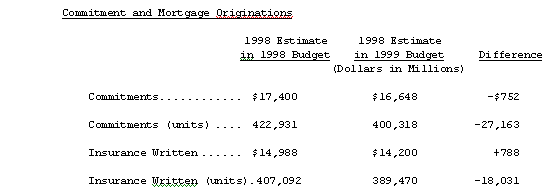
The enacted commitment limitation is $17.4 billion in 1998. This will support initiatives such as development, refinancing and risk sharing as well as recent product introductions such as mixed income, pool insurance and insurance for very small buildings (5-20 units). During fiscal year 1998, mortgage insurance written is expected to decrease to $14.2 billion, compared to the estimate of $14.9 billion in the 1998 Budget. Insurance written numbers represent estimated commitment activities from fiscal years 1997 and 1998.
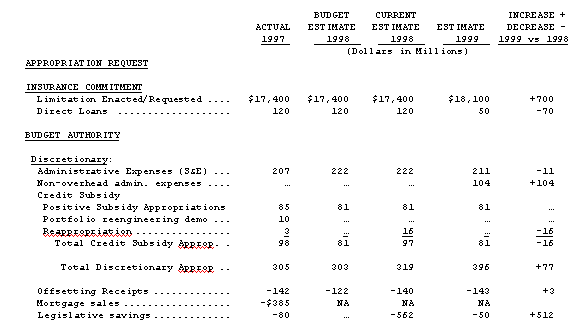
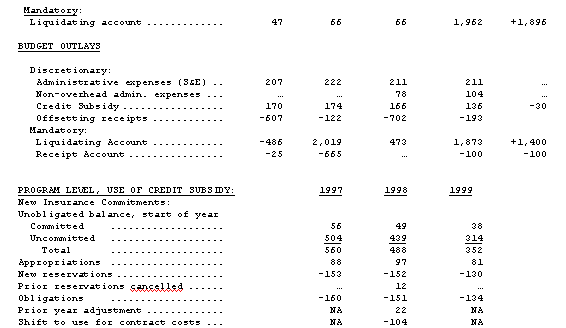

Content Archived: January 20, 2009